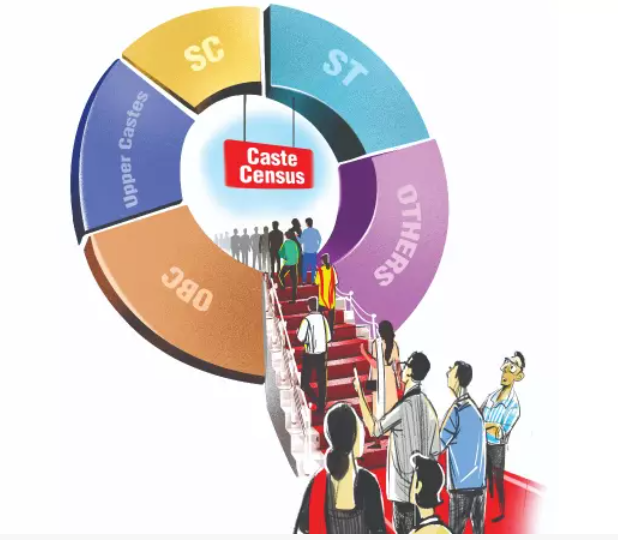The Case for a Caste Census (GS Paper 2, Polity)

Context:
- India, with its vast cultural diversity, has a complex social structure deeply influenced by caste.
- Recently, there has been a renewed call to amend the Census Act of 1948 to make caste enumeration mandatory.
- This change aims to address several social, legal, administrative, and moral imperatives.
About Caste Census:
- Caste-wise enumeration in India began during British colonial rule (1881-1931) but was discontinued in independent India to avoid perpetuating caste divisions.
- However, as caste remains a significant social construct influencing various aspects of life, there is a growing demand for its reintroduction in the Census.
Census Authority:
- Union Subject: Census is a Union subject, but the Collection of Statistics Act, 2008 allows states and local bodies to gather necessary statistics.
- Caste Surveys: States like Karnataka (2015) and Bihar (2023) have conducted caste surveys, but Census data is more authoritative and less contested.
Imperatives for a Caste Census
Social Imperative:
- Caste continues to be a foundational social construct.
- As of 2011-12, only 5% of Indian marriages were inter-caste.
- Caste surnames, marks, and residential segregation by caste persist.
- Electoral and ministerial candidate selection is often influenced by caste.
Legal Imperative:
- Policies of social justice, including reservations, require detailed caste-wise data.
- The Constitution, although using 'class', recognizes caste for defining backward classes and reservations.
- The Supreme Court's rulings emphasize the relevance of caste in upholding reservation policies.
Administrative Imperative:
- Detailed caste-wise data prevents wrongful inclusions/exclusions in reservations.
- It helps sub-categorize reserved categories and set criteria for the creamy layer.
Moral Imperative:
- The absence of detailed data has allowed elites to dominate resources and power.
- A caste census is crucial for addressing historical injustices and ensuring equitable distribution.
Case for OBC Inclusion in Census
Constitutional Provisions:
- Education and Employment Reservations: Permits reservation for OBCs (Article 15(4) and Article 16(4)).
- Mandal Commission Recommendations: OBCs enjoy reservations based on these recommendations.
- Periodic Revision: The Supreme Court mandates periodic revision of the OBC list.
Electoral Constituencies:
- OBCs lack reservation in electoral constituencies for MPs and MLAs, unlike SCs and STs.
- The 73rd and 74th Amendments provide for reservations in panchayats and municipalities for OBCs (Articles 243D(6) and 243T(6)).
- Essential caste-wise data is needed for these provisions.
EWS Reservation:
- The Supreme Court upheld 10% reservation for economically weaker sections (EWS) without empirical data.
- The Census should now include all castes, as done until 1931.
Arguments Against Caste Census
Social Divisiveness:
- Critics argue that caste enumeration could perpetuate casteism.
- However, caste counts of SCs and STs have not led to conflicts.
- Religion, language, and region, also enumerated, can be equally divisive.
Administrative Challenges:
- Caste enumeration is seen as complex, but the government has successfully enumerated SCs and STs.
- Enumerating the remaining castes, mostly state-specific, should be manageable.
Reservation Demands:
- Caste-wise data could address reservation claims objectively.
- Fuzzy data allows arbitrary implementation for electoral gains.
Legal Challenges:
- States' attempts to implement OBC reservations in local elections have been stayed due to lack of caste-wise data.
- The judiciary demands caste-wise data, but the executive has avoided it.
Issues with Socio-Economic and Caste Census (SECC)-2011
- Poor Design and Execution: SECC-2011 was not conducted under the Census Act and was poorly designed.
- Union Ministries Conducted Survey: Ministries of Rural and Urban Development conducted it without prior experience.
- Questionnaire Issues: Open-ended questions led to confusion and inaccurate data, resulting in an impractical figure of 46 lakh castes.
- Data Inaccuracy: The last enumeration in 1931 listed 4,147 castes.
Way Forward for Caste Enumeration in Census
- Amend the Census Act (1948): Make caste enumeration mandatory.
- Census Commissioner's Role: Include caste in the regular Census.
- Pertinent Questions: Add specific caste-related questions to the Census questionnaire.
- Expert Involvement: Enlist sociological/anthropological experts to draft caste lists specific to each state.
- Public Input: Publish the draft list online for public suggestions before finalizing.
- Streamlined Process: Provide enumerators with specific caste lists and use handheld devices for accurate data collection.
- Legal Review: Interested states should move the Supreme Court to review its 2021 judgment.
Conclusion
- A caste census is crucial for informed policy-making and addressing historical injustices. Amending the Census Act to mandate caste enumeration is a significant step towards social justice and equitable development.
- As Peter Drucker said, “Only what gets measured gets managed.” This adage is particularly relevant in addressing the issues faced by historically discriminated social groups.
- Collecting data on caste, like other group identities, is essential for creating an inclusive and just society.


